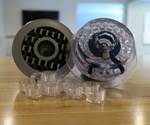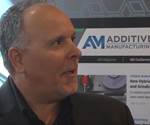Video: The Case for Hybrid Manufacturing in Moldmaking
Instead of relying on EDM to machine features recessed deep into the part, machine those features while 3D printing progresses, finishing them before they become hard to reach.
In this video, Evan Syverson of Sodick discusses hybrid manufacturing—additive manufacturing and CNC machining on the same machine—and its potential in moldmaking. As he describes, one promise is the chance to save cost by reducing the need for EDM. He and I filmed this conversation at the Additive Manufacturing Conference.
Transcript:
Peter Zelinski, Additive Manufacturing
I’m Pete Zelinski with Additive Manufacturing magazine and I’m here with Evan Syverson, additive business development manager with machine tool builder Sodick. Additive manufacturing has promise for moldmaking—you can make mold tooling with conformal cooling channels. But you are adding something to additive. Tell me what you mean by hybrid manufacturing.
Evan Syverson, Sodick
It's the combination of additive manufacturing with subtractive manufacturing in order to give a higher-quality part with greater automation. So it improves the whole workflow and the end result in anything you’re building, really. But at the really granular level, what we’re talking about, at least at Sodick, is we’re talking about a DMLS powder-bed sintering system. So you’re getting the same material properties that you’d want from any other major brand of 3D printer, but you’re also introducing a 45,000-rpm mill that’s able to come in and finish those parts.
Peter Zelinski
In the course of the build, you are pausing periodically to do milling work.
Evan Syverson
When you’re pausing during a print in order to come in and finish those parts, you’re actually getting access to areas of that part that would be more difficult to access otherwise. And that's not just including, let’s say, internal features that maybe you’re going to print over later. So, you have an internal cavity—you could mill that out and actually print something surrounding it like a cage or some kind of ceiling, something like that.
Peter Zelinski
This technology, hybrid—combining machining with additive—it has potential for certain types of features that otherwise would be difficult to accomplish. Where do those kinds of features occur?
Evan Syverson
You see those kinds of features in a lot of very detailed work. So you might have a rib, or a pocket that reaches in several inches, quite deep, and getting a cutting tool that’s actually able to reach all the way down—we’re talking about 3, 4, 5 inches into a pocket like that. That’s going to be rather difficult to actually achieve. So then you have to make an electrode, you have to set up your part in an EDM, and you have to sinker that part. If you’re able to eliminate 50, 60, 70 percent of your sinker EDM work, you can actually eliminate almost half the cost of a mold right there.
Related Content
-
CNC Engineering Integrates 3D Printing Solutions With CNC Machine Tools
CNC Engineering and Meltio have collaborated to design a solution that combines the power and reliability of FANUC CNC with cutting edge additive manufacturing technology.
-
Hybrid Metal 3D Printer Enables Quick-turn Prototyping
IMTS: Matsuura Machinery’s Lumex Avance hybrid metal 3D printers are said to enable lights-out production for highly accurate parts from metal powders.
-
Video: Intelligent Layering Metal 3D Printing at 3DEO
Contract manufacturer 3DEO delivers metal parts using Intelligent Layering, a binder jetting-like 3D printing process the company developed and operates internally. Here’s how it works.















